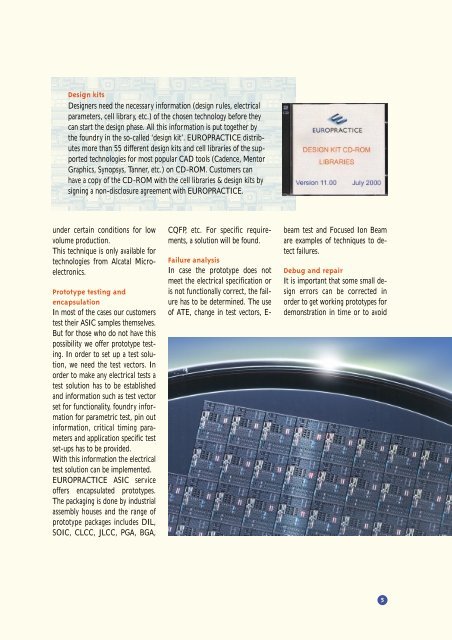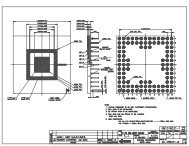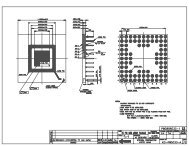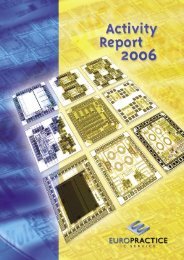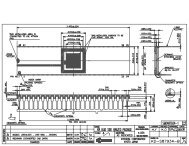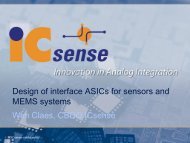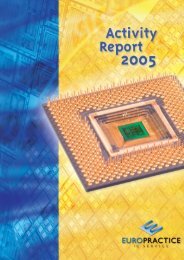Annual report 2000 - Europractice
Annual report 2000 - Europractice
Annual report 2000 - Europractice
You also want an ePaper? Increase the reach of your titles
YUMPU automatically turns print PDFs into web optimized ePapers that Google loves.
Design kits<br />
Designers need the necessary information (design rules, electrical<br />
parameters, cell library, etc.) of the chosen technology before they<br />
can start the design phase. All this information is put together by<br />
the foundry in the so-called ‘design kit’. EUROPRACTICE distributes<br />
more than 55 different design kits and cell libraries of the supported<br />
technologies for most popular CAD tools (Cadence, Mentor<br />
Graphics, Synopsys, Tanner, etc.) on CD-ROM. Customers can<br />
have a copy of the CD-ROM with the cell libraries & design kits by<br />
signing a non-disclosure agreement with EUROPRACTICE.<br />
under certain conditions for low<br />
volume production.<br />
This technique is only available for<br />
technologies from Alcatal Microelectronics.<br />
Prototype testing and<br />
encapsulation<br />
In most of the cases our customers<br />
test their ASIC samples themselves.<br />
But for those who do not have this<br />
possibility we offer prototype testing.<br />
In order to set up a test solution,<br />
we need the test vectors. In<br />
order to make any electrical tests a<br />
test solution has to be established<br />
and information such as test vector<br />
set for functionality, foundry information<br />
for parametric test, pin out<br />
information, critical timing parameters<br />
and application specific test<br />
set-ups has to be provided.<br />
With this information the electrical<br />
test solution can be implemented.<br />
EUROPRACTICE ASIC service<br />
offers encapsulated prototypes.<br />
The packaging is done by industrial<br />
assembly houses and the range of<br />
prototype packages includes DIL,<br />
SOIC, CLCC, JLCC, PGA, BGA,<br />
CQFP, etc. For specific requirements,<br />
a solution will be found.<br />
Failure analysis<br />
In case the prototype does not<br />
meet the electrical specification or<br />
is not functionally correct, the failure<br />
has to be determined. The use<br />
of ATE, change in test vectors, E-<br />
beam test and Focused Ion Beam<br />
are examples of techniques to detect<br />
failures.<br />
Debug and repair<br />
It is important that some small design<br />
errors can be corrected in<br />
order to get working prototypes for<br />
demonstration in time or to avoid<br />
5


